Last month I discussed the differing types of water flow. The idea there was to get people thinking about what type of flow they want in their aquarium. This month I’m going to present some very basic information. This is a review of some of the more common water flow devices used in the hobby.
Powerheads
Powerheads are submersible water pumps. They have an intake and an output. These have been a staple in the hobby for two decades. There are several manufactures but nearly all powerheads look and work the same. They have a housing with two openings (water to come in and water to go out) and they have a spinning impeller. This impeller is a rotating wheel with many blades, and is driven by a magnet. The magnet spins on a ceramic rod spinning the impeller to push out water.
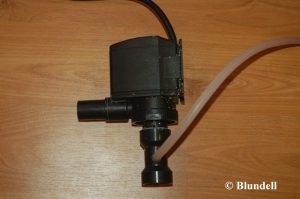
Shown here a standard powerhead. Water is drawn through the opening in the bottom and pushed out the side outlet.
Stream Pumps
After many, many years of the same old thing with powerheads a revolutionary idea came through. Instead of an intake and an output the new series of pumps has a very broad output and the water is drawn in from all sides (a ring pattern around the pump) and the flow produced is a wide almost laminar pattern. I describe this is a cylinder of water moving along with the pump in the middle drawing from behind and pushing forward.
Once this type of engineering came into the hobby it spread like wild-fire. The total amount of water pushed around is vastly greater than typical powerheads and the electrical usage is not increased. These pumps are far superior in terms of efficiency.
Two main types of stream pumps are now available. One is a conversion from a standard powerhead where a modification kit is used to replace part of the powerhead. The second is a manufactured stream pump which is designed with a propeller types of blade and not the standard impeller.

These two pumps may look very similar. One is a stream pump, and the other is a powerhead with a modified casing to create a stream pump.
External Pumps
I just like that term because I’m not sure how else to say it. These pumps are not submersible and must be kept out of the water. For these pumps to work they need plumbing. That is they have a pipe that takes water into their intake and another pipe that takes the water out of their output. These pumps can push a lot of water. On average they produce 10 times the water flow and with a considerable amount of head pressure. These pumps are often used as tank return pumps to push water against gravity back up to the display tank.
In recent years the “closed loop” system as become very popular. It should be noted in my opinion the closed loop is about to face extinction. I think a few years from now we’ll all be looking back on the days’ of the closed loop. The idea here is that the water from the display tank runs down a pipe to the pump, then back up another pipe and into the tank. Because gravity is pulling the water down to the pump, it offsets the force needed to pump the water back up to the tank. It produces almost 0 head loss and the pump can operate at nearly full force. There is more to it than that, but I don’t see reason to cover it. Feel free to email me for more details.

Aquarium Enthusiast “Sukie” shows off her closed loop return system. This system uses four bulkheads where water will re-enter the aquarium. Looking below the aquarium you can see where the water will come out of an external pump, split into four pipes, and go through those pipes back to the tank.
Hang On Filters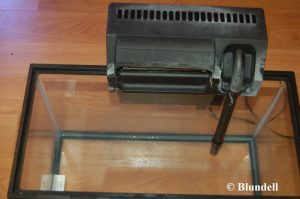
These filters are super popular in the freshwater hobby. However, they are rarely seen in the marine hobby. That may be changing as more and more hobbyists venture into the world of nano tanks. These items are great for producing water flow (especially along the surface) for small aquaria.
Water Direction Changing Devices
There are four different water direction-changing devices that I frequently see. They are a spinning outlet of some type (usually put on a powerhead), a gear driven item that changes the direction of the water, a valve that opens and closes different outlets, and a powered swiveling outlet. The common manufacture/brands of these items are shown here.
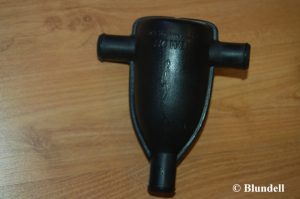
Shown here are a SCWD which uses gears to push water left, then right, then left, then right and so forth. The water moving through the unit pushes the gears.
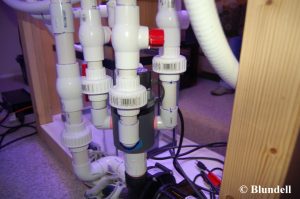
The Ocean Motion shown here is being used to divert the return water from an external pump to alternating outlets.

The actuated ball valve (Hayward Valve) electronically turns a ball valve to direct water in different directions.
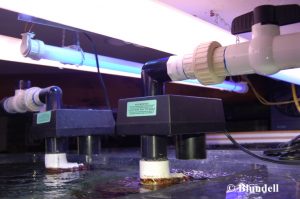
A SeaSwirl is a very common item. This device rotates back and forth at about a 90 degree angle spraying water in a sweeping motion.
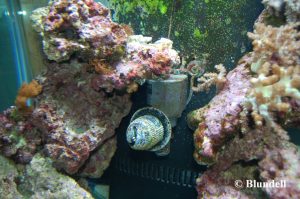
This powerhead has a rotating device on the end which continually spins at a slow speed directing water around in a circle.
Conclusion
While many devices exist for water flow, there are some new revolutionary products on the market and on the horizon. Upcoming articles will introduce these items to the readers. Before exploring these items it is a good idea to learn the basics… and hopefully we just covered that.
Author Information
Adam Blundell M.S. works in Marine Ecology, and in Pathology for the University of Utah. He is also Director of The Aquatic & Terrestrial Research Team, a group which utilizes research projects to bring together hobbyists and scientists. His vision is to see this type of collaboration lead to further advancements in aquarium husbandry. While not in the lab Adam provides services for of one of the Nation’s largest hobbyist clubs, the Wasatch Marine Aquarium Society (www.utahreefs.com). Adam has earned a BS in Marine Biology and an MS in the Natural Resource and Health fields. Adam can be contacted at [email protected].



0 Comments